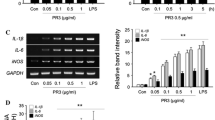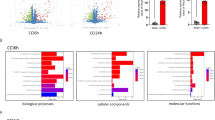Abstract
Background
Acute pancreatitis is an inflammation of the pancreatic glandular parenchyma that causes injury with or without the destruction of pancreatic acini. Clinical and experimental evidence suggest that certain systemic proinflammatory mediators may be responsible for initiating the fundamental mechanisms involved in microglial reactivity. Here, we investigated the possible repercussions of acute pancreatitis (AP) on the production of inflammatory mediators in the brain parenchyma focusing on microglial activation in the hippocampus.
Methods
The acute pancreatic injury in rats was induced by a pancreas ligation surgical procedure (PLSP) on the splenic lobe, which corresponds to approximately 10% of total mass of the pancreas. Blood samples were collected via intracardiac puncture for the measurement of serum amylase. After euthanasia, frozen or paraffin-embedded brains and pancreas were analyzed using qRT-PCR or immunohistochemistry, respectively.
Results
Immunohistochemistry assays showed a large number of Iba1 and PU.1-positive cells in the CA1, CA3, and dentate gyrus (DG) regions of the hippocampus of the PLSP group. TNF-α mRNA expression was significantly higher in the brain from PLSP group. NLRP3 inflammasome expression was found to be significantly increased in the pancreas and brain of rats of the PLSP group. High levels of BNDF mRNA were found in the rat brain of PLSP group. In contrast, NGF mRNA levels were significantly higher in the control group versus PLSP group.
Conclusion
Our findings suggest that AP has the potential to induce morphological changes in microglia consistent with an activated phenotype.













Similar content being viewed by others
References
Fernandes-Alnemri T, Yu JW, Datta P et al. AIM2 activates the inflammasome and cell death in response to cytoplasmic DNA. Nature. 2009;458:509–513.
Szelényi J. Cytokines and the central nervous system. Brain Res Bull. 2001;54:329–338.
Malleo G, Mazzon E, Siriwardena AK et al. Role of tumor necrosis factor-α in acute pancreatitis: From biological basis to clinical evidence. Shock. 2007;28:130–140.
Kreutzberg GW. Microglia: a sensor for pathological events in the CNS. Trends Neurosci. 1996;19:312–318.
Allan SM, Rothwell NJ. Inflammation in central nervous system injury. Philos Trans R Soc B Biol Sci. 2003;358(1438):1669–1677.
Habtezion A, Gukovskaya AS, Pandol SJ. Acute Pancreatitis: A Multifaceted Set of Organelle and Cellular Interactions. Gastroenterology. 2019;156:1941–1950.
Gomez-Nicola D, Perry VH. Microglial dynamics and role in the healthy and diseased brain: A paradigm of functional plasticity. Neuroscientist. 2015;21:169–184.
Latz E, Xiao TS, Stutz A. Activation and regulation of the inflammasomes. Nat Rev Immunol. 2013;13:397–411.
Perry VH, Nicoll JAR, Holmes C. Microglia in neurodegenerative disease. Nat Rev Neurol. 2010;6:193–201.
Perry VH. Contribution of systemic inflammation to chronic neurodegeneration. Acta Neuropathol. 2010;120:277–286.
Macedo-Ramos H, Ruiz-Mendoza S, Mariante RM et al. Streptococcus pneumoniae resists intracellular killing by olfactory ensheathing cells but not by microglia. Sci Rep. 2016;6:36813.
Eulálio JMR, Bon-Habib ACC, de Oliveira Soares D et al. Critical analysis and systematization of rat pancreatectomy terminology. Acta Cirúrgica Bras. 2016;31:698–704.
Ferrero-Andrés A, Panisello-Roselló A, Roselló-Catafau J et al. NLRP3 Inflammasome-Mediated Inflammation in Acute Pancreatitis. Int J Mol Sci. 2020;21:5386.
Kelley N, Jeltema D, Duan Y et al. The NLRP3 Inflammasome: An Overview of Mechanisms of Activation and Regulation. Int J Mol Sci. 2019;20(13):3328.
Ruiz-Mendoza S, Macedo-Ramos H, Santos FA, et al. Streptococcus Pneumoniae Infection Regulates Expression Of Neurotrophic Factors In The Olfactory Bulb And Cultured Olfactory Ensheathing Cells. neuroscience. 2016;317:149–61.
Lacroix S, Feinstein D, Rivest S. The bacterial endotoxin lipopolysaccharide has the ability to target the brain in upregulating its membrane CD14 receptor within specific cellular populations. Brain Pathol. 1998;8:625–640.
Galea I, Bechmann I, Perry VH. What is immune privilege (not)? Trends Immunol. 2007;28:12–18.
Cunningham C, Wilcockson DC, Campion S et al. Central and systemic endotoxin challenges exacerbate the local inflammatory response and increase neuronal death during chronic neurodegeneration. J Neurosci. 2005;25:9275–9284.
Holmes C, Cunningham C, Zotova E et al. Systemic inflammation and disease progression in Alzheimer disease. Neurology. 2009;73:768–774.
Hennessy E, Gormley S, Lopez-Rodriguez AB et al. Systemic TNF-α produces acute cognitive dysfunction and exaggerated sickness behavior when superimposed upon progressive neurodegeneration. Brain Behav Immun. 2017;59:233–244.
Olmos G, Lladó J. Tumor necrosis factor alpha: A link between neuroinflammation and excitotoxicity. Mediators Inflamm. 2014;2014:861231.
Gómez-Nicola D, Fransen NL, Suzzi S et al. Regulation of Microglial Proliferation during Chronic Neurodegeneration. J Neurosci. 2013;33:2481–2493.
Combrinck MI, Perry VH, Cunningham C. Peripheral infection evokes exaggerated sickness behaviour in pre-clinical murine prion disease. Neuroscience. 2002;112:7–11.
De Lucia C, Rinchon A, Olmos-Alonso A et al. Microglia regulate hippocampal neurogenesis during chronic neurodegeneration. Brain Behav Immun. 2016;55:179.
Jackson TC, Kotermanski SE, Kochanek PM et al. Oxidative Stress Induces Release of 2’-AMP from Microglia. Brain Res. 2019;1706:101.
Lehmann ML, Weigel TK, Poffenberger CN et al. The Behavioral Sequelae of Social Defeat Require Microglia and Are Driven by Oxidative Stress in Mice. J Neurosci. 2019;39:5594–5605.
Singhrao SK, Harding A, Simmons T et al. Oral Inflammation, Tooth Loss, Risk Factors, and Association with Progression of Alzheimer’s Disease. J Alzheimer’s Dis. 2014;42:723–737.
Heneka MT, Carson MJ, El Khoury J et al. Neuroinflammation in Alzheimer’s disease. Lancet Neurol. 2015;14:388–405.
Perry VH, Holmes C. Microglial priming in neurodegenerative disease. Nat Rev Neurol. 2014;10:217–224.
Perry VH, Newman TA, Cunningham C. The impact of systemic infection on the progression of neurodegenerative disease. Nat Rev Neurosci. 2003;4:103–112.
Rizzi C, Tiberi A, Giustizieri M et al. NGF steers microglia toward a neuroprotective phenotype. Glia. 2018;66:1395.
Lima Giacobbo B, Doorduin J, Klein HC et al. Brain-Derived Neurotrophic Factor in Brain Disorders: Focus on Neuroinflammation. Mol Neurobiol. 2019;56:3295–3312.
Eyileten C, Sharif L, Wicik Z et al. The Relation of the Brain-Derived Neurotrophic Factor with MicroRNAs in Neurodegenerative Diseases and Ischemic Stroke. Mol Neurobiol. 2021;58:329–347.
Acknowledgments
We thank Claudio Sergio Correa Lau Junior and Dr. Marcus Vinicius Alves da Silva for help with animal care. We also thank Dr. Frederick S. Leal for revising the English in the manuscript.
Funding
Financial support for this work was provided by the Graduate Vice-Presidency of Universidade Federal do Rio de Janeiro (CEPG/UFRJ), the Brazilian Council for Science and Technology (CNPq), and the Rio de Janeiro State Foundation for Research Support (FAPERJ).
Author information
Authors and Affiliations
Contributions
HM-R, FFC, JEFM, and WB-d-C conceived of the study. TC-F performed most of the experiments. FFC and TC-F performed the molecular biology experiments. TC-F and AF performed tissue sample preparation and histology protocols. VLNP, HM-R, and WB-d-C carried out the histological analysis. PCS, TC-F, JMRE, and JEFM developed the model of acute pancreatitis in rats. MMP and WB-d-C conceived of the scheme in Fig. 13, and MMP drew the images. HM-R and WB-d-C wrote the final version of the manuscript. All authors read and approved the final manuscript.
Corresponding author
Ethics declarations
Conflict of interest
The authors declare no confict of interest with regard to the present manuscript.
Ethical approval
The experimental protocol was submitted to the Ethics Committee for the Use of Animals in Scientific Experimentation at the Health Sciences Center of the Federal University of Rio de Janeiro (CEUA-CCS-UFRJ- Registration Number: 01200.001568/2013-87), registered with the National Council for the Control of Animal Experimentation (CONCEA) and approved for execution.
Additional information
Publisher's Note
Springer Nature remains neutral with regard to jurisdictional claims in published maps and institutional affiliations.
Rights and permissions
Springer Nature or its licensor (e.g. a society or other partner) holds exclusive rights to this article under a publishing agreement with the author(s) or other rightsholder(s); author self-archiving of the accepted manuscript version of this article is solely governed by the terms of such publishing agreement and applicable law.
About this article
Cite this article
Cabral-França, T., Cruz, F.F., Silva, P.C. et al. Hippocampal Microglia Activation Induced by Acute Pancreatic Injury in Rats. Dig Dis Sci 69, 148–160 (2024). https://doi.org/10.1007/s10620-023-08167-x
Received:
Accepted:
Published:
Issue Date:
DOI: https://doi.org/10.1007/s10620-023-08167-x




